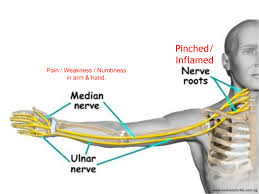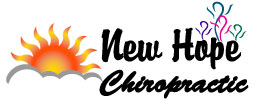Carpel Tunnel Syndrome: Are you having carpel tunnel symptoms and not sure what to do? You may want to consider starting with your neck or upper spine being the cause of your problem first. Degeneration of the discs in the cervical spine or bone spurs associated with arthritis, can cause compression of the nerves which exit the neck and travel down the arm and into the hands. The nerve endings will have a specific distribution to the skin and musculature, which may result in pain, numbness, or weakness when those nerves are compressed. A careful examination can identify the source of the symptoms. For example, if neck extension (leaning backward) causes worsening of the arm pain, there is usually compression of the cervical nerve root in the spine. Similarly, if tucking the chin and tilting the head toward the shoulder opposite the pain gives some relief of symptoms, this is often associated with compression of the nerve in the foramen (spinal nerve opening).
For example, if neck extension (leaning backward) causes worsening of the arm pain, there is usually compression of the cervical nerve root in the spine. Similarly, if tucking the chin and tilting the head toward the shoulder opposite the pain gives some relief of symptoms, this is often associated with compression of the nerve in the foramen (spinal nerve opening).
Carpal tunnel syndrome can be caused by compression of the median nerve through an area of ligaments at the wrist. When the median nerve is compressed, many times patients will complain of pain, numbness, and weakness affecting the thumb, index, and middle finger. Carpal tunnel syndrome is often activity-dependent, meaning that when the hands are used more frequently such as typing or grasping a screwdriver, the symptoms can be exacerbated. Many patients will complain of numbness when they sleep, often from curling the wrist and hand under a pillow.
The difference between cervical radiculopathy and carpal tunnel syndrome is often made clinically by using not only a careful neurologic examination but also by provocative tests, which can often cause irritation of a cervical nerve root in the neck or by tapping the overlying carpal tunnel itself, causing reproduction of symptoms into the hand.
If a careful physical examination cannot disclose the cause of the symptoms, whether it be the neck or the carpal tunnel, then many times an EMG (electromyogram) test may be utilized. The EMG test is utilized to determine the contribution of nerves to the symptoms. The nerve endings may be compressed in the neck or may be compressed as they cross either the elbow or the wrist.
If you are having carpel tunnel and not sure if it coming from the neck or the wrist, call my office for an examination to determine what is causing your condition 401-433-3600
